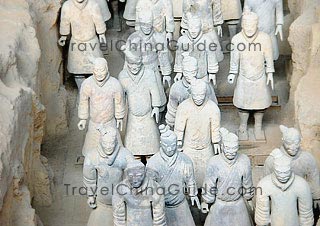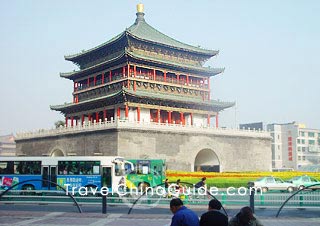Top Facts You Should Know about Xi’an
English Name: Xi’an, Hsian, Sian
Chinese Name: 西安 (xī ān)
History: over 3,000 years long
Used Name: Chang’an, Haojing, Daxing, Xijing
Location: Guanzhong Plain, Shaanxi Province, Northwest China (34°16′N, 108°54′E)
Postal Code: 710000 - 710090
Area Code: 029![]() Read more: Where is Xi’an China
Read more: Where is Xi’an China
Xi’an was the capital of 13 dynasties.
Historically known as Chang’an, Xi’an was home to the ruling house of 13 dynasties, including the Qin (221 BC - 207 BC), Han (206 BC - 220 AD), Sui (581 AD - 618 AD) and Tang (618AD - 908AD) Dynasties.
Xi’an has plenty of historic relics.
Emperor Qin Shi Huang, who set up the first feudal dynasty in Xi’an, left the Terracotta Army which is one of the world's most extraordinary archeological finds. During the Tang Dynasty, Buddhist culture prevailed in Central China, and the Giant Wild Goose Pagoda and Small Wild Goose Pagoda were built to perserve the Buddhist scriptures. In the Ming Dynasty, the City Wall, Bell Tower, and Drum Tower were constructed, which presently attract visits by hundreds of thousands of tourists from home and abroad; these tourists make Xi’an one of the top cities to visit in China.
|
|
Xi’an is the starting point of the Silk Road.
The Silk Road is the world renown ancient trade route that originated during the Western Han Dynasty (1046 BC - 771 BC), stretching from Chang’an (now Xi’an) all the way to the Mediterranean. Evidence of the flourishing trade along the Silk Road can be found in the Shaanxi History Museum and Famen Temple. Another reminder of the enduring legacy of the Silk Road is the Great Mosque, presenting a strong Muslim minority, whose faith remain unchanged although their architectural styles mix Chinese and Western tradition.
Xi’an is a paradise for foodies.
Because of its location in the center of China, Shaanxi cuisine combines various ingredients and cooking skills from both north and south China. Touists can not only taste Crumbled Flatbread in Mutton Stew (Yangrou Paomo), Rou Jia Mo and Liangpi but also eat Gourd-shaped Chicken, Spicy Pig's Kidneys, Quick-boiled Pig's Tripe with Duck, Fish with White Soup and other dishes. Biang Biang Noodles, one of the most representative dishes of Xi’an is worth trying. Muslim Quarter and Yong Xing Fang food streets are popular among tourists.
Xi’an is home to traditional handicrafts and replicas.
Xi'an is famous for excellent reproductions of arts and crafts of the Qin and Tang dynasties, such as Terracotta Warriors Replicas, Tang Tri-color Porcelain Replicas, Calligraphy Rubbings, etc. Beyond that, visitors can also find embroidery, artistic porcelain ware, jade, wood carvings, paper cuttings, and paintings by the farmers of Huxian County which feature strong Chinese traditions and local characteristics. Shuyuanmen Ancient Cultural Street and Moslem Quarter are very popular palces to buy handicrafts and replicas as souvenirs .
Xi’an has a convenient transportation system.
Xi’an Xianyang International Airport, the largest airport in northwest China, serves the domestic and international flights to and from Beijing, Shanghai, Guangzhou, Shenzhen, Hong Kong, Taipei, Tokyo, London, Paris, Bangkok, Singapore, Sydney, etc. In addition, it is a large hub along China’s vast railway network and from here passengers can reach almost every big city and tourism venue in China. Within the city proper, metro lines connect attractions such as the Bell Tower, Drum Tower, City Wall, Giant Wild Goose Pagoda and transportation hubs like North Railway Station.
April to June and Septemeber to October are best times to visit Xi’an.
Xi’an has distinct seasonal weather. Because it is torrid in summer and dry and chiliy in winter, best times to visit is April to June in spring and Septemeber to October in autumn.
Heritages of Ancient City: 2 Days to Provincial History Museum, City Wall, Terracotta Warriors...
Historical Xi'an: 3 Days Luxury visit of the city
Golden Triangle: 8 Days of Beijing and Shanghai

